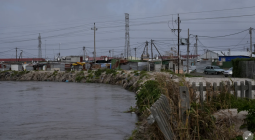Rebuilding Kenya Stronger: Here's What's Needed to Rebound After Catastrophic Floods

Cover Image by: James Wakibia/SOPA Images/Sipa USA/Alamy Live News
In Kenya and throughout East Africa, flooding this past April and May wreaked havoc, leaving a path of deadly destruction. The unprecedented deluge of heavy rainfall resulted in a catastrophe that many in Kenya have never witnessed.
According to a June 18 report by the Kenya Red Cross, the staggering toll from this disaster includes 294 fatalities, 162 missing persons, 101,132 affected households, 151 school disruptions, 45 affected healthcare facilities and 65,377 acres of decimated farmland. The start of the school year’s second term had to be postponed by two weeks and infrastructure, such as roads, railways and bridges were also severely impacted.
Some of the highest impacts from the floods are being felt by people living in informal settlements. In Nairobi, the country’s capital city, over 40,000 households living in informal settlements have been displaced. The Kenyan government has since decided to demolish houses (largely focused on informal settlements) that were built 30 meters on either side of the major rivers of Nairobi.
In addition, these communities have lost sanitation facilities, multiple informal schools that plug the gap of the public school system and spaces where many of the residents earn a living. As a result, the humanitarian crisis for these highly vulnerable communities continues to be dire.
Although heavy rains due to El Niño were predicted, the intensity of the storms have far surpassed its projections, demonstrating how climate change can exacerbate extreme weather phenomena. In fact, these same El Niño effects are also causing the worst drought in 40 years for countries in Southern Africa.
This is not the first time Kenya has suffered from devastating floods. An El Niño 1997 and 1998 also resulted in many fatalities and detrimental destruction. The recent destruction witnessed in Kenya is a testament to the urgent need to rebuild better than in the past. As climate change continues to influence severe storms, Kenya is likely to have more catastrophic climate events.
What Makes Kenya’s Landscapes So Vulnerable?
Kenya’s landscapes are interconnected. The very denuded hills in the Great Rift Valley and the Aberdare Ranges contribute to rapid run-off into rivers downstream that fuels flooding in Nairobi and surrounding peri-urban areas.
Likewise, towns like Narok, located about 142km (88 miles) west of Nairobi, experience cyclical flash flooding because of the degraded water catchments in upstream areas.
These floods have exposed Kenya’s vulnerabilities, poor implementation of plans (such as the 2015-2045 National Spatial Plan and the 2018 Thematic Plan for Disaster Risk Management) and the country’s inadequate disaster preparedness, especially impacting its poorest population.
Nationally, over 38% of the population is characterized as poor, with this figure rising to more than 60% in cities. These communities are disproportionately affected by the floods and have limited capacity to economically cope with climate disasters (through savings or insurance). Yet in most instances, they are the most exposed to climate shocks. Many settlements and low-income housing are also found in the areas most prone to floods and landslides, such as along riverbanks, in flood plains and along dangerously steep slopes.
The major challenge behind Kenya’s multiple development plans is their implementation. Different spatial plans at the national, county and urban levels, for instance, have proposed conserving water catchment areas, climate-proofing infrastructure, introducing early warning systems and creating social safety nets for the poorest. Yet, most of these proposals only collect dust on shelves. For example, despite early warning systems during the most recent floods, the government was slow to respond.
Garbage collection also remains a big problem, especially in large cities like Nairobi. Trash finds its way down rivers to different parts of the city where garbage collection services do not exist.
With a struggling economy, Kenya will need major finances to rebuild its infrastructure at the expense of planned development initiatives. Crops washed away from the floods will mean a huge drop in harvests. Many will go hungry, while farmers will lose income. Rivers are heavily silted because fertile topsoil has been washed away. People will need to borrow or dip into their savings, if any, to restore their homes.
How Kenya Can Build Back Better
To effectively rebuild from this disaster, Kenya will need to intentionally take measures to strengthen its resilience to the impacts of future floods and other weather-related disasters, which are projected to be exacerbated by climate change. Here are the measures it should take:
Nature-based Solutions to Restore Ecosystems
In the immediate aftermath of the floods, Kenya’s government announced a public holiday on May 10 to show respect for those affected by the floods and encouraged people in Kenya to plant trees to help mitigate climate change.
Indeed, carefully planned ecosystem restoration — including in urban areas — will help enhance the resilience of landscapes, reduce erosion and sedimentation, improve water infiltration and provide valuable ecosystem services that help to mitigate flood risks and protect communities and infrastructure from the impacts of flooding.
Furthermore, national and county governments should promote green infrastructure and nature-based solutions, such as wetlands restoration, floodplain reconnection and riparian buffers, to enhance natural flood management and reduce flood risks.
These approaches harness the capacity of ecosystems to absorb, retain, and slow down floodwaters while providing additional benefits such as water purification, habitat conservation and recreational opportunities. However, this is only possible if the country plants the right tree species in the right areas, and robustly monitors landscape restoration, while ensuring that the needs and interests of local communities are safeguarded.
Proper urban planning will help protect infrastructure. County governments must step up compliance, especially in the cities where flooding has been catastrophic. Green spaces in the city must be preserved and construction guidelines should be respected. Most of what happens in cities is directly linked to upstream landscapes where nature-based solutions such as landscape protection and ecosystem restoration can significantly mitigate the impacts of floods and climate change. It is critical that Kenya’s efforts to restore forests and landscapes are kept on course.
As part of its Urban Water Resilience and Cities4Forests initiatives, WRI is providing support to the city of Nairobi and the Nairobi Rivers Commission to increase adoption and investment in community-led solutions for urban river regeneration.
Secure Adaption Financing
Kenya must push for implementation of the Loss and Damage Fund established at COP28 to help rebuild the country’s infrastructure, although the pledges are woefully inadequate. More than ever, the government must mainstream adaptation into its planning processes, coupled with increased access to adaptation finance. The African Adaptation Acceleration Program, for instance, offers an opportunity to scale up nature-based solutions for adapting the continent’s urban and rural infrastructure to climate. The African Development Bank has already surpassed its target of 40% of its total financing to climate finance to 55%. This demonstrates the opportunity for countries to tap into financing for climate adaptation.
Kenya needs to do more robust climate risk assessments and plans to widen the country’s access to adaptation financing opportunities. WRI, through its New Climate Economy program, and the Kenya Institute for Public Policy Research and Analysis (KIPPRA), have created a cross-economy analysis of the existing macro, climate-related and green economic modeling in Kenya, which identified several data management, research, tools and capacity gaps that the government can use to shift to a green economy.
Further measures to enhance the adaptive capacity of economic sectors that are highly sensitive to climate shocks, such as agriculture and tourism, are necessary. The recent floods, for example, necessitated the evacuation of tourists from the world-famous Maasai Mara game reserve during the floods.
Establish and Adopt Effective Early Warning Systems
Early warning systems that provide timely and accurate information about impending floods to at-risk communities can go a long way in helping communities prepare for floods, evacuate safely and minimize loss of life. With climate shocks projected to increase in the future, Kenya should particularly prioritize early warning systems that work for multiple climate hazards, such as droughts, landslides, coastal storms, among others.
Efforts should also be made to conduct comprehensive climate-risk assessments and mapping to identify disaster-prone areas and assess the potential impacts on communities, infrastructure and the environment. This information will serve as the basis for effective flood-risk management planning and decision-making.
Improve Community Engagement
Both the national and county governments should engage with local communities to raise awareness about flood risks, build capacity for preparedness and response, and empower residents to take proactive measures to protect themselves and their properties. Community-based initiatives, such as flood awareness campaigns, training workshops and neighborhood resilience projects, strengthen social cohesion and resilience to floods.
During the recent floods, community-based organizations were the first responders to the crisis. In Nairobi, these groups organized community members to quickly evacuate and also collected data of affected households with speed. These local community groups became the custodians of already established informal mechanisms of warning dissemination and response that can be tapped, enhanced and scaled. Communities must also be empowered to co-develop disaster response strategies and plans together with government agencies.
For a Climate Resilient Future, Kenya Must Act Now
The trail of destruction is already impacting Kenya’s economy. For example, about $8 million will be needed to repair a washed-away railway line important for exporting goods to neighboring Uganda. Nearly $300 million will be needed to fix a network of roads damaged by the floods. And in June, funding was released to reconstruct the schools damaged by the floods.
At the heart of all the proposed solutions must be a nationwide behavioral change: Kenya must stop the indiscriminate dumping of solid waste into storm waterways, corruption and greed that result in ignored regulations or poor-quality works. Lives were lost when buildings collapsed, so building regulations must also be followed to prevent destruction and fatalities when disasters strike.
A collective effort among Kenya’s government and its people will be key to preventing future destruction. Through stewardship, people will thrive with nature and make the world a better place for future generations. We must all step up now.





